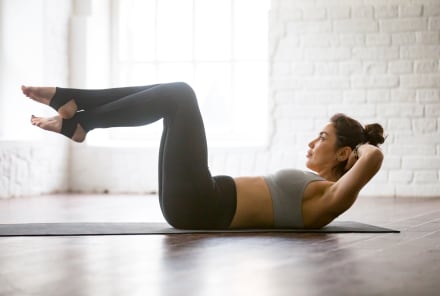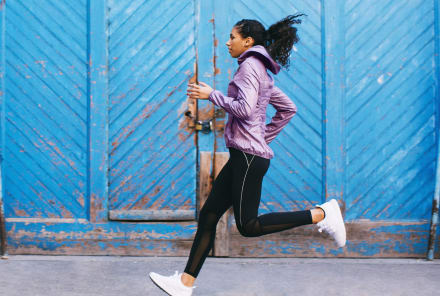Advertisement
3 Ways To Keep Up With Walking In The Winter (And Even Enjoy It)


It's much easier to get outside and walk on days when the sun bathes your verdant surroundings in a golden light until 9 p.m. Getting your steps in on a gray evening with a biting wind chill and slushy sidewalks? That's usually a lot more difficult.
And yet, there's plenty of beauty to experience in winter walking. After challenging myself to walk 20,000 steps a day for a few weeks last summer, I became curious about keeping up with a higher step count through the biting Buffalo winters. So, I reached out to a couple of experts to learn the best ways to get outside and move around during the winter—and maybe even come to enjoy it.
For help walking in winter, we can look to the Nordic people
Swedish-American author Linda Åkeson McGurk doesn't let the short and dark days of Swedish winter prevent her from getting outside. It would be against her life philosophy.
McGurk follows the Nordic concept friluftsliv, pronounced FREE-loofts-leeve, a way of living that involves embracing nature—no matter the season or weather.
Friluftsliv is not hiking up a mountain for clout. It's walking around your local park, noticing the bird sounds and the swaying of dried leaves left on barren trees. It's listening to the crunch of snow beneath your boot and finding pleasure in the sharp, chilly air. It's a way of incorporating nature into your everyday life.
McGurk is an expert on friluftsliv after writing her book, The Open-Air Life: Discover the Nordic Art of Friluftsliv and Embrace Nature Every Day—and she credits the philosophy as one of the reasons Nordic people are routinely named some of the world's happiest.
"Research shows that challenging ourselves, physically and mentally, outside can increase our resilience and also increase our happiness level because our bodies are meant to be active and face these different conditions and not to sit inside in artificial lighting for 10 or 12 hours a day," McGurk says.
Why winter walks are so good for your health
We know walking is really, really good for us—and this doesn't change once temperatures drop.
"If there were a pill that could reduce your risk of heart disease, diabetes, obesity, stress levels, and your risk of getting anxiety and depression, and this pill was entirely free, I'm pretty sure most people would take this pill," McGurk says. "Those are all the effects that you can get from just walking outside every day."
She notes that you don't need to go on long, strenuous hikes in order to reap these benefits either. The ideal amount we should walk every day is debatable, but a 30-minute walk most days is a good starting goal, and 7,000 to 8,000 steps (or about 4 miles) a day is a research-backed amount to walk for increased longevity.
Keeping up with walking during winter can be especially helpful for those who suffer from seasonal affective disorder (SAD), notes psychiatrist Norman Rosenthal, M.D. According to his research, any little bit of exposure to daylight will be beneficial in staving off feelings of seasonal depression.
"You don't need a special cold plunge bath. You just need good clothing, a good attitude, and a little bit of luck that there will be some light coming through the clouds," Rosenthal says.
How to stick with walking until spring
Moral of the story: It's time to give winter walking a try. Viewed through a more charitable lens, the gloomy gray light becomes soft and the slushy sidewalks become charmingly squishy.
Here are some tips on how to incorporate friluftsliv into your life and keep putting those walking shoes to good use through the rest of winter:
Wear proper clothing and accessories
The Scandinavians have another applicable expression: "There's no such thing as bad weather, only bad clothes." Being outside in cold temperatures, snow, and ice is much more fun and comfortable (not to mention safer) when you're wearing the right clothing.
There are a few basic pieces that are worth the investment, such as a pair of snow pants, an insulated coat, waterproof boots, warm hat and gloves, a reflective vest, and ice spikes. However, McGurk stresses that you don't need to buy the latest and fanciest gear. (My snow pants are from the thrift store, for example.)
Know your limits
Let me back up a bit… There is such a thing as bad weather. It's unsafe to walk outside during blizzards, winter storms, and intense wind chills. People who struggle with asthma may have a more difficult time breathing in dry, cold temperatures. It's crucial to understand your limits and build up a tolerance over time—and know when going outside simply isn't worth it. Don't let the pressure of meeting your health app's fitness goal cause you to ignore your body's warning signs that you should take a break.
Look forward to the post-friluftsliv "hygge"
Friluftsliv is the activity that comes before hygge, another Nordic concept of coziness and togetherness that can take many forms. When your cheeks are flushed from your cold walk and you've warmed up with a hot shower, embrace hygge by cooking a comforting meal to eat with your friends and family or by snuggling up on the couch with a book in candlelight.
The takeaway
Your daily walking practice doesn't need to pause each winter. Take a cue from Nordic cultures and honor nature during every season by getting outside and walking in the snow, rain, and chilly temperatures. Just be sure you're not caught in "bad clothes"!

Short On Time? Try This Personal Trainer's 5-Minute Full-Body Workout
Krista Stryker, NSCA-CPT

Short On Time? Try This Personal Trainer's 5-Minute Full-Body Workout
Krista Stryker, NSCA-CPT

Short On Time? Try This Personal Trainer's 5-Minute Full-Body Workout
Krista Stryker, NSCA-CPT

Short On Time? Try This Personal Trainer's 5-Minute Full-Body Workout
Krista Stryker, NSCA-CPT









